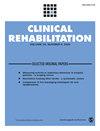The impact of stroke on employment income: A cohort study using hospital and income tax data in Ontario, Canada
IF 2.6
3区 医学
Q1 REHABILITATION
引用次数: 0
Abstract
ObjectiveTo document the impact of stroke on employment income among people employed at the time of stroke.DesignPopulation-based cohort study.ParticipantsPeople hospitalized for stroke in Ontario, Canada (2010–2014) and people without stroke matched on demographic characteristics.Main measuresRobust Poisson regression to estimate the effects of stroke on the probability of reporting employment income on tax returns over 3 years. Quantile regression difference-in-differences to estimate the changes in annual employment income attributable to stroke.ResultsStroke survivors were increasingly less likely to report any employment income poststroke, incidence rate ratios (IRR) 0.87 at 1 year (95% confidence intervals [CI]; 0.85–0.88), 0.82 at 2 years (95% CI; 0.81–0.84) and 0.81 at 3 years (95% CI; 0.79–0.82). IRR for reporting at least 50% of prestroke income levels were 0.76 at 1 year (95% CI; 0.75–0.78), 0.75 at 2 years (95% CI; 0.73–0.77) and 0.73 at 3 years (95% CI; 0.71–0.75). IRR for reporting at least 90% of prestroke income levels were 0.72 at 1 year (95% CI; 0.70–0.74), 0.66 at 2 years (95% CI; 0.64–0.68) and again 0.66 at 3 years (95% CI; 0.64–0.68). Relative changes in annual employment income attributable to stroke varied from a decrease of 13.8% (95% CI; 8.7–18.9) at the 75th income percentile to a decrease of 43.1% (95% CI; 18.7–67.6) at the 25th income percentile.ConclusionsIt is important for healthcare and service providers to recognize the impact of stroke on return to prestroke levels of employment income. Low-income stroke survivors experience a more drastic loss in employment income and may need additional social support.中风对就业收入的影响:利用加拿大安大略省医院和所得税数据进行的队列研究
研究对象加拿大安大略省因中风住院的患者(2010-2014 年)以及与人口统计学特征匹配的无中风患者。主要测量指标通过稳态泊松回归估计中风对 3 年内纳税申报表中报告就业收入概率的影响。结果中风幸存者在中风后报告任何就业收入的可能性越来越低,1 年的发病率比 (IRR) 为 0.87(95% 置信区间 [CI];0.85-0.88),2 年为 0.82(95% CI;0.81-0.84),3 年为 0.81(95% CI;0.79-0.82)。报告至少 50% 中风前收入水平的 IRR 在 1 年为 0.76(95% CI;0.75-0.78),2 年为 0.75(95% CI;0.73-0.77),3 年为 0.73(95% CI;0.71-0.75)。报告至少 90% 中风前收入水平的 IRR 在 1 年为 0.72(95% CI;0.70-0.74),2 年为 0.66(95% CI;0.64-0.68),3 年再次为 0.66(95% CI;0.64-0.68)。中风导致的年就业收入相对变化从收入百分位数第 75 位的减少 13.8% (95% CI; 8.7-18.9) 到收入百分位数第 25 位的减少 43.1% (95% CI; 18.7-67.6)。低收入脑卒中幸存者的就业收入损失更严重,可能需要额外的社会支持。
本文章由计算机程序翻译,如有差异,请以英文原文为准。
求助全文
约1分钟内获得全文
求助全文
来源期刊

Clinical Rehabilitation
医学-康复医学
CiteScore
5.60
自引率
6.70%
发文量
117
审稿时长
4-8 weeks
期刊介绍:
Clinical Rehabilitation covering the whole field of disability and rehabilitation, this peer-reviewed journal publishes research and discussion articles and acts as a forum for the international dissemination and exchange of information amongst the large number of professionals involved in rehabilitation. This journal is a member of the Committee on Publication Ethics (COPE)
 求助内容:
求助内容: 应助结果提醒方式:
应助结果提醒方式:


